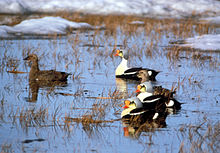King eider
| King eider | |
|---|---|

| |
| Male at Central Park Zoo, New York, USA | |
| Scientific classification | |
| Kingdom: | |
| Phylum: | |
| Class: | |
| Order: | |
| Family: | |
| Subfamily: | |
| Genus: | |
| Binomial name | |
| Somateria spectabilis (Linnaeus, 1758)
| |
The king eider (Somateria spectabilis) is a large sea duck. It breeds along Northern Hemisphere Arctic coasts of northeast Europe, North America and Asia. The birds spend most of the year in coastal marine ecosystems at high latitudes. They migrate to the Arctic tundra to breed in June and July. They lay four to seven eggs in a scrape on the ground lined with grass and down.
The king eider winters in arctic and subarctic marine areas, most notably in the Bering Sea, the west coast of Greenland, eastern Canada and northern Norway. It also happens yearly off the northeastern United States, Scotland and Kamchatka. Breeding areas include the Arctic coastal tundra of the north coast of Alaska. This species dives for benthic invertebrates, such as crustaceans, polychaete worms, and molluscs, with mussels being a favoured food. Wintering birds can form large flocks on suitable coastal waters, with some flocks bigger than 100,000 birds.

This species is smaller than the common eider. The male is unmistakable with its black body, white breast and multicoloured head. The drake's call is a deep cooing.
The female is a brown bird. They can still be told apart from all ducks except other eider species on size and structure. The head is shorter than in the common eider, and the feathering onto the bill is rounded, not triangular in shape.
An immature drake is typically all dark with a white breast and a yellow bill patch.
Traditional Uses
[change | change source]
The king eider is a regular source of fresh meat in the spring. They begin their migration past the Yukon-Kuskokwim Delta in late April and are hunted in great numbers. In May, several hundred thousand eiders pass Point Barrow in northern Alaska on their way to Alaskan and Canadian breeding grounds.

References
[change | change source]- ↑ BirdLife International (2004). Somateria spectabilis. 2006 IUCN Red List of Threatened Species. IUCN 2006. Retrieved on 11 May 2006. Database entry includes justification for why this species is of least concern

